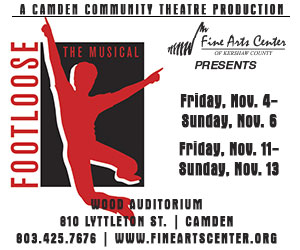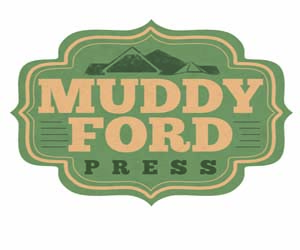Ernest Lee: A Man and His Chickens
By William Garland
The Lorraine
Wind pours down the street while Ernest Lee frantically tries to pick up the fallen sheets of painted plywood that are strewn across the lot. The scene is almost comical. Lee has an unkempt look about him. There are flecks of white hair scattered throughout his two-day stubble that stand in stark contrast to his black hair and dark amber skin. He is a tall man, but his playful mannerisms and soft-spoken voice prevent him from ever really looking as tall as he is. These characteristics are only amplified as he runs from one painting to the next. Each time he picks one up and gingerly resets it, another one falls. I’d already offered to help once, but he insisted that he’d been dealing with this wind for eleven years and he knew just how to manage it. “You can set em up if want, but I’m gonna have to set up again once you finish.” He’d just laughed as he lowered his frame to reposition a dancing, red chicken.
This was about the time that his painting of the Lorraine Motel got caught up in a gust. He says that this painting is the one that sets him apart from most folk or pop artists. There is a precision to this painting that none of his other ones possess. He tells me that he’d spent over 100 hours on this one, and that it is his best work. It does tower over the hundreds of other paintings of chickens and palmetto trees that had been hurriedly scrawled onto scraps of plywood in both size and precision. The painting of the Lorraine Motel is an incredible rendition of the scene where Martin Luther King, Jr. was assassinated. As if you expect Ralph Abernathy and Jessie Jackson to somehow appear beyond the edge of the frame, still grieving. And now it’s been caught by a low gust of wind and its massive frame contorts under the pressure of being flung onto the unyielding shoulder of Harden Street.
Lee drops the dancing chicken and rushes over to the Lorraine. “Shoot! Shoot! Shoot! Don’t do it now! Not today!”
The giant, metallic chicken that proudly stands in front of his makeshift shack is the next victim of the wind. Its feet get swept up and its rusted and dented head rolls into a series of smaller crabs and chickens that were being displayed over in the corner. Lee doesn’t seem to notice. He stands there with his arms outstretched above his head as he clings to either side of the Lorraine and examines his brush strokes for damage. There are none. There are a few scratches on the frame, but nothing a little paint won’t fix. He’s escaped a disaster he can’t afford to have. He looks over my way with his signature grin. “That’d been the end of it. Already gonna cost me $3,300 to replace the van. Gotta make some money. Ain’t made it yet.” He tentatively sets the Lorraine down against a telephone pole, stops to look at it one more time, and goes back over to his chickens.
The After Party
I met Ernest Lee for the first time last May. He’d set his work up over in our neighborhood park during the annual tour of homes. My wife, Leah, and I had walked over to his corner of the park to look at a few of his signature chickens. Before we had time to comment on the ones we liked, Lee had already struck up a conversation with us.
While we were getting ready to bend over and take a closer look at a stack of paintings, I heard, “Well, well, how’d you get so lucky to land you a pretty girl like that.” This was quickly followed by, “How many Chicken Man paintings y’all need today?”
We joked around with him briefly. Telling him what we did. What we thought about the neighborhood. Said we’d lived in Columbia too long not to have a Chicken Man painting. He agreed. And we told him we weren’t quite ready to make a decision, but we’d be back. He laughed, “Y’all know Chicken Man will take care of you, right. I’ll take good care of y’all. Tell me how many y’all want, and I’ll give you a deal. Just tell me which ones.”
We told him we’d be back.
He responded, “I’m holdin’ y’all to it, now.”
We laughed as we walked away, never turning around to see his response.
Later that night, we were having a drink on our neighbors’ patio when the familiar late model, green Mercedes pulled up out front. The mid-eighties car was stacked full of painted plywood. I’d passed by that car so many times on Harden Street, and now here it was, in front of our house. Lee stepped out of the car and was immediately greeted by our neighbor, Christy, who’d jumped out of her chair and ran over to give the man a hug and welcome him to her home. We found out later that Christy had also seen him at the park and told him that she wanted him to come over to the after party at her house and have a drink with her friends. She told Lee that there would be several people there, and that she would make sure everyone walked away with at least one painting, even if she had to buy the art for them. Lee immediately recognized Leah and I, and with genuine a smile said, “Y’all ‘bout decided on which Chicken Mans you need?”
We left the party with two.
The Roadside Attraction
He’s a local icon, or at least a fixture. Friends who’d gone to the University of South Carolina or who were from Columbia had his work displayed in bathrooms and breakfast nooks. My barber had a particularly enthusiastic and brightly colored chicken that dated all the way back to ‘87. And when Leah and I were house hunting, every house we toured had at least one chicken staring back at us. His stuff seemed to be everywhere.
We first saw Lee’s open-air tent on a grassy shoulder off of Huger Street. There was a line of college-aged girls waiting to buy a chicken. One group of three girls was gathered around Lee to have their picture taken with him. There was an energy at this roadside setup and Leah mentioned that we needed to stop by sometime and get a painting. I wasn’t as sure. We had a somewhat conservative collection of art in our home, mostly consisting of black and white photography, watercolors, and prints. The most intriguing painting that we had was an oil painting of a little girl, arms outstretched, balancing on a rail. It was a colored painting with streaks of red and thick brush strokes. But it was just a pop of color in an otherwise neutral room. These chickens were a different story . They defied color logic and defined a room. I was interested in the Chicken Man, but I wasn’t sold.
A few years went by and I saw more and more of his artwork. It began to grow on me. The unknown man behind the work had grabbed my imagination. I wanted to know who this man was. I saw him more and more on the side of the road. First on Huger. Then on Harden. Sometimes there was a crowd outside of his shack. Other times he sat there alone. But he always seemed happy. Laughing and interacting with cars that passed by. One day when I got caught at a red light in front of his booth, I watched him talk to a group of birds that had come within a few feet of him to eat the bread and peanuts that he’d thrown out for them.
Leah finally convinced me that we needed to buy at least one of his paintings. For several months, every time we walked into someone’s home that had folk art on their walls, she made me look at it and admit that it was a nice addition to their home. She was usually right. And when we saw Lee in the neighborhood park, we’d decided that we were going to actually get one. I just wasn’t sure where we could put it. We spent the rest of that day discussing where we could hang a chicken.
By the time we walked away from our neighbor’s after party with two of his paintings under our arms, I wanted to know who this guy really was. The man was forever jovial. He was this presence in town that sat on the roadside and sold paintings of chickens to college students and a younger generation of South Carolinians. They were paintings that didn’t require much technical precision.
But the art displayed around the chickens was of a different nature. There were buildings, landscapes, and portraits, and they all showed a dedication and a soulfulness that only came from someone who had poured themselves into them. And yet they sat. Countless patrons walked up and asked for their own unique version of a chicken or a palmetto tree. And all of his other art went unnoticed.
I was intrigued. As a writer, I wanted to find out if this was what it took to be successful. To make a name for yourself. Did we have to abandon our dreams of becoming the next great folk artist or writer in order to achieve a sustainability that provided for our family? And if we did abandon that dream for a commercial or popular brand of ourselves, was that going to be enough? Or would we still risk sitting on a roadside wondering where the money for the next bill was going to come from? All of these questions were weighing on me in the months following my encounter with this cheerful man who had convinced me put two of his paintings in my house. And I took all of these questions with me when I asked him if I could just sit with him for a day. He seemed receptive to the idea, as long as I considered adding another painting to my collection. I agreed.
The Set Up
It’s a lonely day, sitting alongside Harden Street. Lee gets to his painted trailer around 10:00 each morning and begins the process of setting up. Sometimes he has a friend who comes by and helps him set up for a few dollars. Sometimes he doesn’t. When it’s just him, it takes about an hour to unload the trailer and Mercedes. He starts with the trailer. Unloading the paint covered tables and chairs, and then the canvas cover for his tent that has been set in buckets of concrete. Wearing his wool cap and his fingerless gloves, he moves on over to the giant metallic chicken and the larger pieces of art. Making sure the Lorraine is set up out front. In plain sight. Then he works his way down to the smaller paintings and the ones in his car. Strategically placing them all around the abandoned parking lot. He does this at a frantic pace, placing them just like he’s done so many times before, only occasionally stepping back to see how they might look to people passing by on the road. Once the smallest ones are placed on the table and spread about on the pavement, he walks back to his car to get a few Chicken Man t-shirts on hangers, before settling in and waiting .
It All Started with a Bantam Chicken
Lee started painting when he was twelve. As a child, he painted pretty much anything that came to his mind. Despite several assumptions around Columbia about him being a self-taught folk artist, Lee studied at both the Gertrude Hebert Institute of Art in Alexandra, Virginia, and the Rose Hill Art Center in Aiken. Until he moved to Columbia eleven years ago, he lived and painted in North Augusta. There, his painting was more of a side project and when he tried to sell it, he focused most of his attention towards the flea markets.
He tells me, “There weren’t always the chickens.” It wasn’t until sometime in the mid-seventies that he stumbled upon the chicken idea. “I met this guy named Tom Webb over in Thompson, Georgia, who asked me why I never painted no chickens?” Laughing he said, “I’d told him I had me some bantam chickens, and he said I ought to paint em.” Lee was convinced nobody would ever buy any chickens, but at the time he felt like he didn’t have anything to loose . He started painting chickens that looked like real chickens. Giving a lot of attention to their combs and the way their feathers spread across their wings, before moving onto their tail feathers and talons. They never really sold, so he adjusted them, made them “funky.” He started to spatter drops of paint across rough sheets of tall, skinny plywood, and painted elongated, emaciated chickens that liked to dance. Natural colors no longer mattered. A chicken could end up being purple and green just as easily as red and white. Nature longer mattered. And before Lee realized it, “Folks had started askin’ around for the chicken man.”
Lee tells me that he used to paint variations on “three little boys sittin’ on a stump eatin’ watermelon.” Those were his big sellers. They were similar to paintings that Jim Harrison used to make. Harrison is a localized artist from Denmark, SC, who focuses on depicting realistic portrayals of rural scenes from the South. He was and still is Lee’s favorite artist. But to understand that influence you have to look past the scrawled out chickens and palmetto trees and pay attention to his other work, which is often buried off to the sides and in the back of his painted shack. It is there that you can start to see the more realistic portrayals of southern landscape and culture. These are the ones that make Lee smile when you ask about them. Those, and the one of the Lorraine.
The Long Lull
Most days are slow. A few college students wander in and out, and buy one or two small paintings for fifteen or twenty dollars, but it’s mostly slow. Lee tells me, “Most days I got to wait all day until the evening, when folks be gettin’ off work. That’s when the sales come. That’s the thing about it. You got to sit all day before you can even think about makin’ a sale.”
Lee confesses that if I weren’t around he’d set himself up by the space heater in his shack and listen to the news on his little transistor radio. I look into this shack on wheels and try and imagine him set up amidst the hundreds of stacked paintings, painting supplies, and boxes of t-shirts. It’s difficult to picture it. But Lee says he’s content in his little shack. I tell him he shouldn’t stay out here in the cold on my account, but he just laughs.
I’d been eyeing a painting of a covered bridge for a while. The blues and greens mix together in a way that both ground the painting and make it surreal. The sky has a stillness to it. The clouds sit in a solitary haze and a power line dips in and out of view. But the rest of the painting has movement. The grass, the road, and the walls of the bridge all move with the brush strokes that created them, leaving me with this surreal experience of standing still while my eyes travel beneath this covered bridge at interstate speeds.
Lee, noticing my fascination, walks up to me. “I can get you a good deal on that covered bridge. I’ll even throw in a couple of chickens.”
“Let’s talk again before I leave.”
Lee laughs, and says again, “I’ll get you a good deal. Chickens and all.”
Still staring at the bridge, I inquire about how many of these types of painting he sells, Lee responds without hesitation, “Not many.” He guesses that he’s painted over 11,000 paintings and more than half of those were chickens. People want their piece of a local icon. It’s trendy – but only when their guest can recognize it as one of the Chicken Man’s paintings. They want what they know. And they know about the dancing chickens.
He starts to hum an old Motown tune and turns away from me to work on the metallic chicken that is still overturned and headless. When he bends over I can no longer make out the tune, the drumming of passing cars is a constant presence, and now it’s drowned out everything else. A series of rapid-fire honks of acknowledgement or one-sided interest break into the white noise. Lee smiles and waves. He appears to be friends with every passing car. Always smiling. Always laughing. He seems to enjoy himself. Even if they never stop.
I ask him if he regrets painting so many chickens. With an emphatic shake of his head he responds, “People have come to know me as the Chicken Man. That’s who I am here. Them chickens been good to me.”
Traveling Man
Before his van broke down in Baltimore, on his way up to Boston this past spring, Lee spent a lot of his time traveling to art shows around the country. Most artists can’t survive without traveling. The local markets just aren’t sustainable over any extended period of time. And without the constant revolving influx of college students and parents, Lee would be having an even more difficult time supporting himself and his family off of his craft. Traveling is just a part of it. Many extremely successful artists spend every weekend on the road, spending large amounts of money on gas, hotels, and festival entry fees with the hope of finding a new market that will buy their work . And even for the most established commercial artists, the shows are little more than crapshoot .
Lee says that he’s been to shows in Chicago, Boston, New Orleans, Atlanta, Key West, and about every other city you can think of. “Some are good. Some ain’t.”
But that’s the nature of it. Several years ago, Lee thought that he could go down to Key West and “folks would just eat it up.” But he got all the way down there only to discover that he had to buy a license that he couldn’t afford, and after two days he had to turn around. “You live and you learn. That’s just part of it, I reckon.”
As I look around at the hundred of unsold paintings situated all around us it becomes clear to me why the traveling shows are so important. I ask Lee about my suspicions.
“Customers here tell me how to paint em. They want me match’em up to their wallpaper. I don’t choose the colors. They do. That’s fine. I charge a little extra. We’re all happy.” And yet he admits that he has a lot of money tied up in inventory. “I got more paintings than I could ever sell. But folks like to see their options. They like to know what I can do.” But more often than not, these just sit and wait for him to go to a show. That’s where Lee can sell what he’s already painted. “Every now and then you get somebody that wants somethin’ else, but most folks at shows, they buy what I got.” That’s also where Lee has the best chance of selling his non-commercial work. He’s sold a good many portraits and landscapes at those shows. And at every show, he pulls out his painting of the Lorraine and sets it up front and center.
The Afternoon Push
Late in the afternoon a car swings around and lunges into the parking lot, and a middle-aged woman and her teenaged daughter climb out and begin thumbing through the stacks of paintings propped against Lee’s Mercedes. Lee nods his head at me, in a manner that seems to indicate that this might be the sale he’d been waiting on. Walking towards the mother and daughter, he removes his cap, and with a smile that I can hear, boasts, “How many Chicken Man paintings can I get you beautiful ladies today?”
They blush, saying they are going to look around for a while.
“Well I can get you some deals. I’ve got more over there. There are more in the trailer. You want a bunch of em. I’ll get you some deals.”
Listening to him talk, I notice how it never sounds forced or even that pressured. The words alone should sound high-pressured. But they don’t. He smiles and flirts with these ladies and it is one of the most genuine encounters that I’ve ever witnessed.
Wandering in and out of the stacks and the trailer, the two of them laugh as they pick up paintings of chickens and flamingos. They are flipping through one of the stacks inside the trailer when another car pulls up bearing a USC sticker and sorority letters. The girl that gets out and walks up to the table to start combing through the smallest paintings on the table before deciding on a crab. Lee tries to talk to her. Joke around a little, but she only asks, “Do you have this crab in an 8×10?”
Lee finds another crab on a square shaped sheet of plywood that’s roughly the size of a floor tile. “This here is about as close as I’ve got to a 8×10.”
The girl grabs it and examines it for a minute, before settling on the smaller crab that she’d first chosen. Twenty dollars and she’s gone.
The mother and daughter continue their search before deciding on two chickens and a brightly colored flamingo. They chat with Lee for a few minutes. The daughter is celebrating some undisclosed achievement at middle school, and the mother wanted to do something special for her. Lee’s smile is larger than usual, and I know that this sale will make his day. He needed this one.
They all gather around his table as he situates the paintings for their final preparation. Without hesitation, the girl jumps into one of the chairs beside Lee and watches as he pulls out a series of acrylics and brushes to add the legs and the finishing touches to her chickens. With a liberal glop of gray paint on the table, Lee dips his brush into the paint and allows the bristles to become saturated before lifting his hand and gliding it across the plywood. Without any discerning series of steps two legs begin to form on each painting and the chickens start to take on their full potential. He uses his fingers to clean the brush. Lee continues to mix in a series of other red and whites to add to the beaks and the combs, before settling into his signature on the bottoms of the paintings. Her anticipation turns into an odd series of squirms as he twists the eyehook and wire into the back of the plywood. They are finally ready for her, and she eagerly grabs all three of them and rushes off to their car as her mother pays.
Both of us wave at the mother and daughter as they leave the parking lot. This was a good sale. “I need me a few more of those,” he laughs.
I laugh with him, but I couldn’t help but notice that they never even looked at his other work. The paintings that he seemed to really care about. Here were two customers who were genuinely interested in his craft. They asked questions. They took their time flipping through his work, but they never even noticed this other aspect of his collection.
Looking at the Lorraine Motel, I ask him again about whether or not he is upset about how nobody ever notices his other work. He looks at the motel and gently smiles. “The chickens have been good to me. I can’t turn my back on the Chicken Man.”
“But it has to get hard. Having all of these paintings and not being able to sell them. How do you do it?”
“I’m always hopin’. I’d like to get somebody to come buy it out. Buy everything. That’d be good. Gotta find an art lover for that.” He looks over at me and points back to his trailer, “You ‘bout ready to go back over there and think about that bridge I got.”
I agree that it is about that time. He begins to pick up the smaller paintings and load them into his car, as I walk into the trailer. The covered bridge really is astonishing. Once again, I am caught by the surreal movement of the brush strokes. They move me in and out of the bridge. I’m still staring at the painting when Lee walks up behind me with an armful of paintings. “I’ll cut you a deal. Throw in a chicken and one of my Chicken Man shirts.”
Once again, I walk away with two paintings under my arm.






.jpg)
